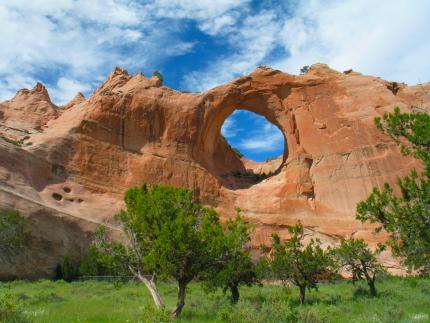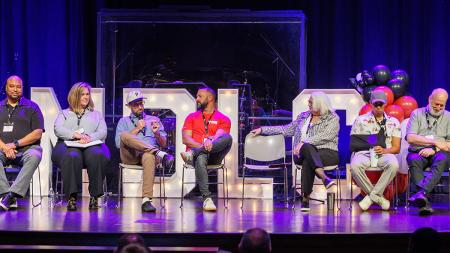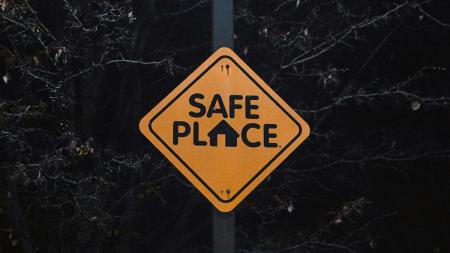Navajo Christians Build Relationships

When asked how many Navajo people identify as Christian or how many members his church has, Stanley W. Jim responds, "That's a very Western culture type of question. Western culture always wants to talk about numbers and results. For Native cultures, it's all about relationships."
Jim is the pastor of Window Rock Christian Reformed Church (WRCRC) in Window Rock, Arizona, capital of the Navajo Nation. He was the project director for WRCRC's Vital Worship Grant project to contextualize worship practices by engaging scripture in ways reflective of Navajo cultural practices. The congregation prioritized Navajo language and cultural practices, adapted its learning during the COVID-19 pandemic, and built lasting relationships beyond church walls.
Using Navajo/Diné Language in Worship
Jim explains that Navajo is the term Spanish colonizers used for his people, who refer to themselves as Diné, which means “the people.”
“When I'm talking with Anglos, I say Navajo,” Jim says “Among ourselves we say Diné.”
Although Jim had already been preaching in Navajo and English, the grant project intensified emphasis on speaking Navajo in worship and sermon discussions. The grant application described historical and current trauma that affects Native people in the congregation and community. People still alive today were forcibly removed from their homes, put in boarding schools, and forbidden to speak their heart language. Missionaries counseled Native Christians to abandon their cultural music, stories, celebrations, and other practices.
These traumas, along with federal injustices such as the forced Long Walk of the Navajos in the 1860s and continued broken promises about health and infrastructure funding, make many Navajos see the Bible as another untrustworthy product of the dominant white society.
But Jim and the grant team believed that experiencing the Bible as Diyin God Bizaad (God's Holy Word) would help people view the Bible as God's love letter spoken directly to them. They trusted that this change would help worshipers become hearers of the Word who live out their faith in daily life.
"Preaching in Navajo helps older people grasp it easier and helps younger people learn the language,” Jim says. “Maybe 90 percent of older adults at our church understand the Navajo language. Some younger people understand, but feel bashful to speak. Pre-pandemic, we were getting high school kids who came to church and gatherings because they wanted to listen to people speaking Navajo. One teen who's third generation in our church speaks it well, and he would read it in worship.
"I used to read Navajo in worship and Navajo Bible reading sessions, while people listened. During the grant project, I asked them to read along with me. Then later I said, 'From here on, we will have you folks read. It doesn't matter if you struggle with pronunciation.' Gradually, more people volunteered to read. Most times we would read through the Navajo hymn for the worship service. Other times they'd choose a song of praise from the hymnal, Psalms, or Daniel [e.g. Daniel 2:20–23] in the Navajo Bible."
The grant included Sunday morning classes in reading the Bible and hymns in Navajo. For responsive readings and hymns in English, the worship team also displayed the Navajo text. "Once I asked people to read through Psalm 6 and then write down—in Navajo or English—what was going through their mind, whether a song, a thought, or a prayer,” Jim says. “One person wrote a wonderful poem in English that we later used in worship. An elderly woman wrote a prayer in Navajo as a song came to her. I am helping her put it to music." Jim is also a well-known musician in the Navajo Nation.
Celebrating Shared Culture
Window Rock CRC discovered during its grant project that celebrating shared culture, such as traditional stories, intergenerational meetings over meals, and Navajo greetings, helped people move from being hearers of the Word to active doers of the Word.
"In seminary we were taught to use only one or two illustrations per sermon, but I use a lot of traditional stories and references in my sermons,” Jim says. “In a Romans 8 sermon on how the Holy Spirit helps, intercedes for, and strengthens us, I told the story of Crow sitting on Standing Rock. Coyote comes to Standing Rock. Nobody likes Coyote because he's a trickster. Coyote asks, 'Crow, what are you doing?' Crow says, 'I'm holding up this rock to keep it from falling. Won't you come to help me?' Mr. Coyote says, 'Yes, I'll help you.' He then leans in and pushes on the rock with all his strength. Then Crow flies off. Coyote is beside himself, losing so much energy, pushing on that rock so it won't fall on him. As he looks up, he feels and believes the rock indeed is falling. He doesn't realize that he sees clouds moving, not the rock falling. I explained that the Holy Spirit will not fly away from us like Crow."
In fall 2019, the WRCRC grant team began hosting monthly discussions and potlucks around tables inside the sanctuary. "People value intergenerational gatherings,” Jim says, “so once we had kids sing and do a little program. Another time we included a cake walk in a Reformation Night of Celebration, and we had close to a hundred people. We played games where the winners got to choose a cake. People who normally don't go to church really enjoyed these gatherings.”
Like other WRCRC members, Jim cites his clan memberships when meeting other Diné people: "I use the traditional values of learning which related clans we have in common. So I call them my brother, father, grandma, or whatever. Knowing our clan relationships links us together and gives us a sense of belonging. From then on, conversation is much easier. Because I make contact in this way, I've had traditional people come to me later with requests for prayer or help with burials."
Learning Together amid COVID-19
The grant team had planned to start learning circles led by fluent Diné speakers so people could discuss sermons and apply them to living out their faith. They discovered that people were actually more likely to talk when they discussed as one large group. Jim says the grant team realized that hearers were becoming doers when members began to invite friends, relatives, and others to worship, potlucks, and holiday dinners at WRCRC.
Then the coronavirus arrived. "The pandemic messed us up,” Jim says. “The husband of a congregation member was one of the first to die of COVID-19. We lost a woman who was a deaconess. A father and son died within days of each other. We were praying for each other left and right, and we're grateful that just a handful of our church got sick.”
Stay-at-home orders and capacity limits on group gatherings forced WRCRC to change plans for gathering after worship for sermon discussions and potlucks. Some congregations in Classis Red Mesa (a regional group of Christian Reformed churches) had drive-in services where people listened from their cars. When the Navajo Nation’s COVID-19 infection rate dropped to yellow status and limited capacity, Window Rock CRC resumed in-person worship. These were shorter hybrid services with up to twenty-five people in the sanctuary and everyone else on Zoom.
"The grant really helped us get the video equipment and subscriptions we needed to be able to worship through Zoom,” Jim says. “At first, our internet connection was spotty, but the Navajo Nation kept upgrading, and so did we. We leave time in Zoom services for worshipers to unmute and share about changes they plan to make because of the sermon. Many reservation churches also joined our virtual worship.
"Only about half our congregation can Zoom, so the church council began to record and archive all my sermons for people who cannot log on to the internet. But for those with no computer or even Wi-Fi access through a phone, the council puts my sermons on CDs, and we deliver them out to people who request them.”
Meanwhile, Jim and WRCRC improved their technical skills through trial and error. In October 2020, they made more efforts to minister to children within Zoom worship. Jim’s wife, Sharon, designed the first few kids’ segments, which come before the congregational prayer.
"She was a natural,” Jim says. “Other Sunday school teachers started getting comfortable and confident in bringing messages of hope to the children. Within five or ten minutes, they read scripture, pray with the kids, present the gospel, and insert an easy craft to do at home. On Mother's Day, Sharon used her purse to present the gospel—like when you travel anywhere, you need certain things, like ID. She explained that baptism is our identification in Jesus Christ. I get so many texts and emails about how the adults appreciate what they are learning along with the kids.”
Building Relationships Beyond the Congregation
Adding virtual worship and sermons on CD led to unexpected benefits, such as more worshipers, deeper relationships, and increasing church giving.
"Pre-pandemic, we had three or four families where only the wife or mother came to church. Many of our people live with multiple generations in the same home,” Jim says. “[But] because of Zoom, these women's husbands and children began to hear the Word. One of the best moments in all my years of ministry came when I visited a home where the husband was able to sit back in a relaxed situation where no one was looking at him. He asked me about Christian history and what I'd preached. I came away praising the Lord.
"Members began inviting family members, co-workers, friends, children, neighbors within the community and from off reservation communities to join us on Zoom,” Jim adds. “Also, many people consider themselves part of WRCRC even when they move to larger cities for work. Zoom lets them participate in worship from far away. Some now read Scripture in worship. The person who hosts our Zoom worship is a sociology professor in British Columbia, Canada.”
Jim credits WRCRC’s deacons with helping to maintain relationships during and beyond the grant year and pandemic. They used phone calls, text messages, and visits when that was allowed. He adds that many people who called to share struggles mentioned how much they appreciated the work of WRCRC member Mary Huyser, a retired child welfare expert: "Ladies would join her by phone or Zoom for weekly meditations on joy. She'd read a text and ask them to draw or paint a response. She also did a weekly 'Coffee with Mary' Zoom time."
Deeper relationships prompted members and visitors to give more faithfully to the church—more than what they usually gave during live worship services. In its final report, the grant team wrote, "We realized that we became a living organism in God's kingdom after the COVID-19 pandemic dispersed us. This prompted us to decide that we will continue with the Zoom ministry even after the ban on coming together is lifted on the Navajo Nation."
Learn More
In this 2021 Calvin Symposium on Worship service (56:57 to 57:32), Stanley Jim gives the blessing in Navajo. This short video (04:06) features Jim, who received a 2021 Distinguished Alumni Award from Calvin Theological Seminary. A well-known country gospel musician in the Navajo Nation, he translated “Amazing Grace” using a traditional Navajo music style for the Lift Up Your Heartshymnal.
The churches in Classis Red Mesa are many miles apart. Stanley Jim and his wife, Sharon, helped start the Red Mesa Leadership Development Network to train more Indigenous pastors and preachers. Since Jim lives in Window Rock, capital of the Navajo Nation, he often meets and prays with Navajo leaders such as President Jonathan Nez, who is a Christian.
Kinship and clan membership are essential to Navajo identity. People traditionally introduce themselves by explaining which clans they are from. Every Navajo belongs to four clans, with the mother's first clan being most important.
Navajo leaders from Christian Reformed and other denominations participated in a 2019 Talking Circle about healing from cultural trauma and being both Navajo and a follower of the Jesus Way. Read the 45-page Talking Circle summary by Donnie Begay. He and his wife, Renee Begay, worked for years with Nations: A Cru Ministry.
Start a Discussion
Feel free to print and distribute this story at meetings of your staff, board, or education, worship, or arts committees. These questions will help people start a conversation about contextualizing scripture:
- What fraction of your worship service is devoted to Bible reading?
- Which heart languages or cultural practices might you use to help worshipers engage more deeply with the Bible?
- In your context, how would you know whether hearers of the Word are becoming doers of the Word?


